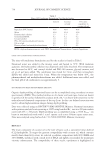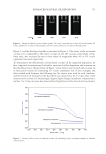735 ENHANCED NATURAL OIL DEPOSITION Figure 2, and the rheological profile is presented in Figure 3. The clarity of the structured coconut oil is comparable to the native coconut oil, but the viscosity, particularly at low- shear rates, was increased by two to four orders of magnitude when 4% or 6% acrylic copolymer was used, respectively. To demonstrate the effectiveness of structured coconut oil for improved deposition, we first compared an unstructured oil with a structured oil for deposition and retention on bleached hair tresses. Shown below in Figure 4, hair tresses were treated with coconut oil or structured coconut oil (containing 2% acrylic copolymer), left to dry overnight, and then washed with shampoo the following day. Six tresses were used for each condition, and the level of oil retained on the hair fibers was observed to be 2.5 times that of the unstructured coconut oil. Interestingly, despite slight changes in polymer composition, a similar 2 to 3 times increase was observed for all polymers in this class of oil structurants. Figure 3. Overlay of flow curves of (refined) coconut oil containing acrylic copolymer samples at different concentrations. Figure 2. Images of refined coconut oil (first panel), 2% acrylic copolymer in coconut oil (second panel), 4% acrylic polymer in coconut oil (third panel), and 6% acrylic polymer in coconut oil (fourth panel).
736 JOURNAL OF COSMETIC SCIENCE With evidence that the acrylic copolymers aid in the deposition and retention of the coconut oil on the bleached hair fibers, we next sought to understand the localization of each component on the hair fiber. SIMS is a powerful analytical tool that is capable of chemical imaging of surfaces. SIMS images are shown in Figure 5. The total ion image is influenced by the topography (left panel), which is why the cuticles are easily seen, as well as changes in chemistry. In this case the chemistry has negligible effect. Polymer signal from the methacrylate monomers (C 4 H 5 O 2, middle panel) is detected on all regions of the hair, but seems to be concentrated in some smaller regions, in particular on the top hair. Coconut oil (C 12 H 23 O 2 , right panel) appears to have a uniform distribution this image is affected by the topography of the hair. Using two ion beams, where one beam is used for analysis and the second is used for etching, a depth profile can be constructed to characterize any layering in the deposited layer on hair. For this treatment, a depth profile, as shown in Figure 6, shows lauryl sulfate Figure 5. Negative ion SIMS images from structured coconut oil treated hair. C4H5O2 is from methacrylates, and C12H23O2 is from coconut oil. The field of view is 200 × 200 μm. The intensity scale for the images is shown to the right where black is no signal and white is the maximum signal. Figure 4. Comparison of coconut oil quantification on bleached hair with and without acrylic copolymer.
Purchased for the exclusive use of nofirst nolast (unknown) From: SCC Media Library & Resource Center (library.scconline.org)






































































































































